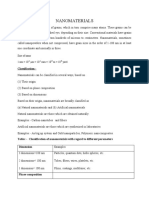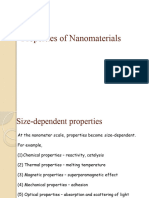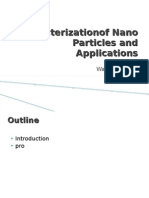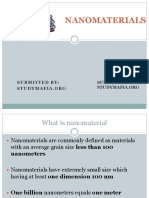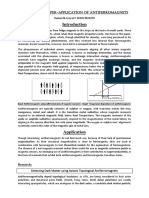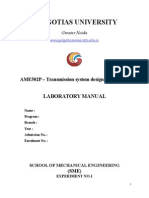0 ratings0% found this document useful (0 votes)
313 viewsNano Science and Technology
Nanoscience deals with the scientific study of objects with sizes in the 1 – 100 nm range in at least one dimension.
Nanotechnology deals with using objects in the same size range to develop products with possible practical application. It is usually based on nanoscience insights.
Uploaded by
Agnivesh SharmaCopyright
© © All Rights Reserved
Available Formats
Download as PPTX, PDF, TXT or read online on Scribd
0 ratings0% found this document useful (0 votes)
313 viewsNano Science and Technology
Nanoscience deals with the scientific study of objects with sizes in the 1 – 100 nm range in at least one dimension.
Nanotechnology deals with using objects in the same size range to develop products with possible practical application. It is usually based on nanoscience insights.
Uploaded by
Agnivesh SharmaCopyright
© © All Rights Reserved
Available Formats
Download as PPTX, PDF, TXT or read online on Scribd
You are on page 1/ 33
Module 1
Nanoscience and nanotechnology
Nanoscience deals with the scientific study of
objects with sizes in the 1 100 nm range in
at least one dimension.
Nanotechnology deals with using objects in
the same size range to develop products with
possible practical application. It is usually
based on nanoscience insights.
Nanoscience
Nanoscience is interesting in part of course
because it by definition is new. But a more
profound and important reason is that it deals
with objects which are only slightly larger than an
atom. This means that the properties of the
objects can be influenced by direct
manifestations of quantum mechanics.
It is also possible that nanoscale objects do
behave just like as expected from (semi)classical
physics, but the downgrading in size opens up
possible new applications.
Nanotechnology
Nanotechnology is the creation of functional
materials, devices, and systems through control
of matter on the nanometer (1 to 100 nm) length
scale and the exploitation of novel properties and
phenomena developed at that scale.
A scientific and technical revolution has begun
that is based upon the ability to systematically
organize and manipulate matter on the
nanometer length scale.
Ancient nanotech.
It is interesting to note that there has been
use of what now would definitely be called
nanoscience much before the advent of the
word.
- Vases used by old Greeks and Romans
Nanoscale
Defining Nanoscale
Cross section of human hair
Nano - Dwarf
Nano size: 1 nm = 10
-6
millimeter (mm) = 10
-9
meter (m) nm
Combination of atoms or molecules to form objects of nanometer scale
Importance of nanoscale
The wavelike properties of electrons inside matter are
influenced by variations on the nanometer scale. By
patterning matter on the nanometer length, it is
possible to vary fundamental properties of materials
(for instance, melting temperature, magnetization,
charge capacity) without changing the chemical
composition.
The systematic organization of matter on the
nanometer length scale is a key feature of biological
systems. Nanotechnology promises to allow us to place
artificial components and assemblies inside cells, and
to make new materials using the self-assembly
methods of nature.
Importance of nanoscale
Nanoscale components have very high surface
areas, making them ideal for use in composite
materials, reacting systems, drug delivery, and
energy storage.
The finite size of material entities, as compared to
the molecular scale, determine an increase of the
relative importance of surface tension and local
electromagnetic effects, making nanostructured
materials harder and less brittle.
The interaction wavelength scales of various
external wave phenomena become comparable
to the material entity size, making materials
suitable for various opto-electronic applications.
11
Nano-materials: Used by humans for 100 of years, the beautiful ruby red color
of some glass is due to gold Nano particles trapped in the glass (ceramic)
matrix.
The decorative glaze known as
luster. Ruby Red glass pot
(entrapped with gold
nanoparticles)
Bulk. In bulk materials, only a
relatively small percentage of
atoms will be at or near a
surface or interface (like a
crystal grain boundary).
Nano. In nanomaterials, large no.
of atomic features near the
interface.
Whats special with Nano?
The properties of nanomaterials deviate from those of single crystals or polycrystals
(bulk). For example, the fundamental properties like electronic, magnetic, optical,
chemical and biological Surface properties: energy levels, electronic structure, and
reactivity are different for nano materials.
Exhibit size dependent properties, such as lower melting points, higher energy
gaps etc. On the Surfaces and interfaces basics:
Nanostructured materials
Nanoparticles
Nanowires
Nanotubes
Nanorods
Nanoporous materials
Other structures
Bulk and Nanoscale
Density of states for 3D, 2D, 1D, 0D showing discretization of energy and discontinuity of DOS
Effects of Nano size
Properties depends on size, composition and structure
Nano size increases the surface area
Change in surface energy (higher)
Change in the electronic properties
Change in optical band gap
Change in electrical conductivity
Higher and specific catalytic activity
Change thermal and mechanical stabilities
Different melting and phase transition temperatures
Change in catalytic and chemical reactivities
Bulk and Nanoscale
Bulk (eg. Gold) Nano (eg. Gold)
1. LustrousShiny surface when
polished.
2. MalleableCan be hammered,
bent or rolledany desired shape.
3. DuctileCan be drawn out into
wires
4. Yellow colour when in a mass
5. Heat & electricity conductor
6. High densities
7. High melting point (1080
o
C)
8. Tough with high tensile strength
9. Inert-unaffected by air and most
reagents
1. Vary in appearance depending on
size & shape of cluster.
2. Are never gold in colour!.
3. Are found in a range of colours.
4. Are very good catalysts.
5. Are not metals but are
semiconductors.
6. Melts at relatively low temperature
(~940 C).
7. Size & Shape of the nanoparticles
determines the color.
8. For example; Gold particles in
glass:
25 nm Red reflected
50 nm Green reflected
(Unexpected visible properties & they
are small enough to scatter visible
light rather than absorb)
Size variation
Various size of CdSe nanoparticles and their solution. The bulk CdSe is black
Optical properties of Gold NPs
Size, shape, change the optical
properties of nano sized gold
18
4.1.1.1 Gold nanoparticles
Size
increase
Size increase
Red
Green
Orange
Yellow
Blue
Brown
Fig 1. Size and
shape dependent
colors of Au & Ag
nanoparticles
Silver : Bulk - Nano
In nano size not only the surface area increased the electronic
properties are modified. This influence the optical, electrical,
catalytic properties
It improve the selectivity in catalysis
Silver nanocubes Silver nanowires
Silver nanoparticles
Change in shape and size shows the difference in the
visible spectrum of Ag nanoparticles
The scattering or absorption is due to the localized surface
plasmon resonance
SPR
Surface plasmon resonance SPR: The collective
oscillations of the electron gas at the surface of
nanoparticles ( eg. 6s electrons of the conduction
band for Au NPs) that is correlated with the
electromagnetic field of the incoming light, i.e., the
excitation of the coherant oscillation of the
conduction band.
SP band provides some information regarding NPs
band structure
( see the notes for detailed information)
Silicon
SiO
2
- Nanotubes
SiO
2
- Nanospheres
Si - SiO
2
- Nanotubes
Nano - Silicon
Si nanostructures shows visible luminescence
because of quantum confinement
Surface modification and change in size of
particles influences the luminescence
wavelength and intensities
Alkyl passivated Si nanoparticles
Effects of nanoscale on properties
See the notes provided
Nano characterization techniques
Spectroscopy UV-Vis, Surface enhanced Raman scattering, X-ray
photoelectron spectroscopy, Nuclear magnetic resonance
Electrical conductivity measurement
Magnetic measurements
Microscopic techniques Scanning electron microscopy, Transmission
electron microscopy, Atomic force microscopy, Scanning tunneling
microscopy
uses- morphology, Surface force measurement, surface roughness,
Imaging with atomic level resolution, lattice parameter,
Issues
Health hazard
The greater specific surface area (surface area per unit
weight) may lead to increased rate of absorption
through the skin, lungs, or digestive tract and may
cause unwanted effects to the lungs as well as other
organs. However, the particles must be absorbed in
sufficient quantities in order to pose health risks
DNA damage iron oxide , Zinc oxide Titanium dioxide
and Carbon nanotubes causes DNA damage at low
levels. Copper oxidewas found to be the worst
offender, and was the only nanomaterial identified by
the researchers as a clear health risk
Issues
Nanoparticles in water
Nanoparticles in exhaust gases
Nanoparticles in atmosphere
Applications
See the notes provided
Nanophotonics
Photonic crystals are new types of optical materials, in which small
dielectric cells with the size of optical wavelength (from several 100 nm to
several 10 m) are periodically arranged in two- or three-dimensions.
Nanophotonics
Photonic crystal with a diamond lattice.
Nanomedicine - Drug delivery
You might also like
- Chemistry Project Report Class 12 Cbse 2020-2021 Oon Topic Adsorption71% (49)Chemistry Project Report Class 12 Cbse 2020-2021 Oon Topic Adsorption15 pages
- Introduction To Nanoscience & Nanotechnology100% (2)Introduction To Nanoscience & Nanotechnology40 pages
- GE2023 Fundamentals of Nanoscience L T P C3 0 0 3 Unit I 9No ratings yetGE2023 Fundamentals of Nanoscience L T P C3 0 0 3 Unit I 936 pages
- Nanomaterials: 1. Basics of Nano Materials and Nanochemistry - Features Nanoscience and NanotechnologyNo ratings yetNanomaterials: 1. Basics of Nano Materials and Nanochemistry - Features Nanoscience and Nanotechnology5 pages
- Unit - V Nanomaterials: Contents: Properties of Materials at Reduced Size: Electrical, Optical, Mechanical and MagneticNo ratings yetUnit - V Nanomaterials: Contents: Properties of Materials at Reduced Size: Electrical, Optical, Mechanical and Magnetic12 pages
- Techniques For Synthesis of Nanomaterials (I)No ratings yetTechniques For Synthesis of Nanomaterials (I)40 pages
- Synthesis of Nanomaterials Using Various TopNo ratings yetSynthesis of Nanomaterials Using Various Top18 pages
- Advanced Electrochemistry - PPT - FYBtechNo ratings yetAdvanced Electrochemistry - PPT - FYBtech26 pages
- SYLLABUS For Nanotechnology Anna Univ TrchyNo ratings yetSYLLABUS For Nanotechnology Anna Univ Trchy20 pages
- Engineering Physics I Sample Questions: MODULE-2-Crystallography Q1100% (1)Engineering Physics I Sample Questions: MODULE-2-Crystallography Q110 pages
- Synthesis and Characterization of Nitrogen Doped Aluminium Oxide - Copy 2 PDFNo ratings yetSynthesis and Characterization of Nitrogen Doped Aluminium Oxide - Copy 2 PDF40 pages
- Characterization of Nano Particles and Applications100% (1)Characterization of Nano Particles and Applications32 pages
- LECTURE 15-1: Synthesis and Preparation of Nanomaterials (Crystalline and Thinfilm)No ratings yetLECTURE 15-1: Synthesis and Preparation of Nanomaterials (Crystalline and Thinfilm)30 pages
- Quantum Size Effect/ Quantum Confinement EffectNo ratings yetQuantum Size Effect/ Quantum Confinement Effect11 pages
- Use of Nanotechnology in Cement-Based Materials PDF100% (1)Use of Nanotechnology in Cement-Based Materials PDF5 pages
- Fourier Transform InfraRed Spectroscopy (FTIR)No ratings yetFourier Transform InfraRed Spectroscopy (FTIR)29 pages
- Chapter-I Introduction To Nanomaterials: Sathyabama UniversityNo ratings yetChapter-I Introduction To Nanomaterials: Sathyabama University31 pages
- Sr. MIS Executive - Fix Sat Sun - Off - Pune Male Candidates OnlyNo ratings yetSr. MIS Executive - Fix Sat Sun - Off - Pune Male Candidates Only2 pages
- Galgotias University: Laboratory ManualNo ratings yetGalgotias University: Laboratory Manual52 pages
- Please Affix Recent Passport Size Photo (Colour)No ratings yetPlease Affix Recent Passport Size Photo (Colour)1 page
- Fuels Liq Manufacture of Metallurgical Coke: Beehive Oven Otto Hoffmann Oven0% (3)Fuels Liq Manufacture of Metallurgical Coke: Beehive Oven Otto Hoffmann Oven51 pages
- Galgotias University: Course Topics: (Syllabus)No ratings yetGalgotias University: Course Topics: (Syllabus)1 page
- Janna Engineering Heat Transfer (BookFi) - 492-496No ratings yetJanna Engineering Heat Transfer (BookFi) - 492-4965 pages
- CHE S204 Chapter 9 Unsteady State Heat Transfer G1No ratings yetCHE S204 Chapter 9 Unsteady State Heat Transfer G111 pages
- Chapter 28 - Synthetic Polymers (Test Bank)100% (1)Chapter 28 - Synthetic Polymers (Test Bank)20 pages
- Full download (Ebook) Solid Lubrication Fundamentals & Applications (Materials Engineering) by Kazuhisa Miyoshi ISBN 0824789059 pdf docx100% (3)Full download (Ebook) Solid Lubrication Fundamentals & Applications (Materials Engineering) by Kazuhisa Miyoshi ISBN 0824789059 pdf docx81 pages
- Guideline For Feld Testing of Reciprocating Compressor Performance PDF100% (1)Guideline For Feld Testing of Reciprocating Compressor Performance PDF173 pages
- Instant ebooks textbook Chapter 12 - Neural network potentials Jinzhe Zeng & Liqun Cao & Tong Zhu download all chapters100% (3)Instant ebooks textbook Chapter 12 - Neural network potentials Jinzhe Zeng & Liqun Cao & Tong Zhu download all chapters51 pages
- Process Instrumentation: Dr. Fahad Rehman Department of Chemical Engineering CUI, Lahore CampusNo ratings yetProcess Instrumentation: Dr. Fahad Rehman Department of Chemical Engineering CUI, Lahore Campus23 pages
- Grundfos Category Heading Grundfos Boiler Feed ManualNo ratings yetGrundfos Category Heading Grundfos Boiler Feed Manual32 pages
- SS 2 1ST Term Scheme of Work Week 6-9 ContinuationNo ratings yetSS 2 1ST Term Scheme of Work Week 6-9 Continuation8 pages
- Seth Boriel - Lab - Enzyme Substrate ReactionNo ratings yetSeth Boriel - Lab - Enzyme Substrate Reaction4 pages
- Chemistry Project Report Class 12 Cbse 2020-2021 Oon Topic AdsorptionChemistry Project Report Class 12 Cbse 2020-2021 Oon Topic Adsorption
- GE2023 Fundamentals of Nanoscience L T P C3 0 0 3 Unit I 9GE2023 Fundamentals of Nanoscience L T P C3 0 0 3 Unit I 9
- Nanomaterials: 1. Basics of Nano Materials and Nanochemistry - Features Nanoscience and NanotechnologyNanomaterials: 1. Basics of Nano Materials and Nanochemistry - Features Nanoscience and Nanotechnology
- Unit - V Nanomaterials: Contents: Properties of Materials at Reduced Size: Electrical, Optical, Mechanical and MagneticUnit - V Nanomaterials: Contents: Properties of Materials at Reduced Size: Electrical, Optical, Mechanical and Magnetic
- Engineering Physics I Sample Questions: MODULE-2-Crystallography Q1Engineering Physics I Sample Questions: MODULE-2-Crystallography Q1
- Synthesis and Characterization of Nitrogen Doped Aluminium Oxide - Copy 2 PDFSynthesis and Characterization of Nitrogen Doped Aluminium Oxide - Copy 2 PDF
- Characterization of Nano Particles and ApplicationsCharacterization of Nano Particles and Applications
- LECTURE 15-1: Synthesis and Preparation of Nanomaterials (Crystalline and Thinfilm)LECTURE 15-1: Synthesis and Preparation of Nanomaterials (Crystalline and Thinfilm)
- Use of Nanotechnology in Cement-Based Materials PDFUse of Nanotechnology in Cement-Based Materials PDF
- Chapter-I Introduction To Nanomaterials: Sathyabama UniversityChapter-I Introduction To Nanomaterials: Sathyabama University
- Sr. MIS Executive - Fix Sat Sun - Off - Pune Male Candidates OnlySr. MIS Executive - Fix Sat Sun - Off - Pune Male Candidates Only
- Fuels Liq Manufacture of Metallurgical Coke: Beehive Oven Otto Hoffmann OvenFuels Liq Manufacture of Metallurgical Coke: Beehive Oven Otto Hoffmann Oven
- Janna Engineering Heat Transfer (BookFi) - 492-496Janna Engineering Heat Transfer (BookFi) - 492-496
- CHE S204 Chapter 9 Unsteady State Heat Transfer G1CHE S204 Chapter 9 Unsteady State Heat Transfer G1
- Full download (Ebook) Solid Lubrication Fundamentals & Applications (Materials Engineering) by Kazuhisa Miyoshi ISBN 0824789059 pdf docxFull download (Ebook) Solid Lubrication Fundamentals & Applications (Materials Engineering) by Kazuhisa Miyoshi ISBN 0824789059 pdf docx
- Guideline For Feld Testing of Reciprocating Compressor Performance PDFGuideline For Feld Testing of Reciprocating Compressor Performance PDF
- Instant ebooks textbook Chapter 12 - Neural network potentials Jinzhe Zeng & Liqun Cao & Tong Zhu download all chaptersInstant ebooks textbook Chapter 12 - Neural network potentials Jinzhe Zeng & Liqun Cao & Tong Zhu download all chapters
- Process Instrumentation: Dr. Fahad Rehman Department of Chemical Engineering CUI, Lahore CampusProcess Instrumentation: Dr. Fahad Rehman Department of Chemical Engineering CUI, Lahore Campus
- Grundfos Category Heading Grundfos Boiler Feed ManualGrundfos Category Heading Grundfos Boiler Feed Manual
- SS 2 1ST Term Scheme of Work Week 6-9 ContinuationSS 2 1ST Term Scheme of Work Week 6-9 Continuation

















